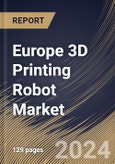In aerospace, where lightweight and intricate components are critical, these robots have become instrumental in crafting complex parts with unparalleled precision. The ability to reduce material waste and create intricate geometries has positioned these robots as a transformative force in aircraft and spacecraft manufacturing. Utilization of these robotics has similarly transformed the manufacturing of custom implants, prosthetics, and medical devices within the healthcare industry. The technology's capability to create patient-specific solutions has opened new frontiers in personalized medicine, providing tailored healthcare solutions that were once deemed unattainable.
Moreover, the automotive industry, always at the forefront of technological innovation, has embraced these robots for rapid prototyping, customized components, and even the production of end-use parts. This adoption has accelerated design cycles and contributed to developing lightweight and fuel-efficient vehicles. Likewise, as the adoption of these robots grows, companies explore novel applications and expand their utilization beyond traditional manufacturing processes. The inherent flexibility of these systems allows for agile responses to market demands, making them an indispensable asset for forward-thinking industries.
Germany is known for its prowess in advanced manufacturing technologies. In particular, the aerospace and defense sectors benefit from cutting-edge technologies, including 3D printing or additive manufacturing. According to the International Trade Administration data, Germany is Europe's third-largest aerospace and defense sector, with 2022 revenues at EUR 39 billion or USD 41.1 billion. Some three quarters or USD 30 billion of the German production are exported. Thus, Europe's rising aerospace and defense sector will assist in expanding the regional market.
The Germany market dominated the Europe 3D Printing Robot Market by Country in 2022, and would continue to be a dominant market till 2030; thereby, achieving a market value of $275.6 million by 2030. The UK market is exhibiting a CAGR of 13.4% during (2023 - 2030). Additionally, The France market would experience a CAGR of 15.3% during (2023 - 2030).
Based on Component, the market is segmented into Robot Arms, 3D Printing Heads, and Software. Based on Application, the market is segmented into Prototyping, Tooling, and Functional Part Manufacturing. Based on Robot Type, the market is segmented into Articulated Robots, Cartesian Robots, Scara Robots, Polar Robots, Delta Robots, and Others. Based on End User, the market is segmented into Aerospace & Defense, Construction, FMCG, Culinary, Automotive, and Others. Based on countries, the market is segmented into Germany, UK, France, Russia, Spain, Italy, and Rest of Europe.
List of Key Companies Profiled
- Kuka AG (Midea Group Co., Ltd.)
- ABB Group
- Yaskawa Electric Corporation
- FANUC Corporation
- Universal Robots A/S (Teradyne, Inc.)
- Massive Dimension
- CEAD B.V.
- Caracol
- Meltio3D
- Comau S.p.A. (Stellantis N.V.)
Market Report Segmentation
By Component- Robot Arms
- 3D Printing Heads
- Software
- Prototyping
- Tooling
- Functional Part Manufacturing
- Articulated Robots
- Cartesian Robots
- Scara Robots
- Polar Robots
- Delta Robots
- Others
- Aerospace & Defense
- Construction
- FMCG
- Culinary
- Automotive
- Others
- Germany
- UK
- France
- Russia
- Spain
- Italy
- Rest of Europe
Table of Contents
Companies Mentioned
- Kuka AG (Midea Group Co., Ltd.)
- ABB Group
- Yaskawa Electric Corporation
- FANUC Corporation
- Universal Robots A/S (Teradyne, Inc.)
- Massive Dimension
- CEAD B.V.
- Caracol
- Meltio3D
- Comau S.p.A. (Stellantis N.V.)








